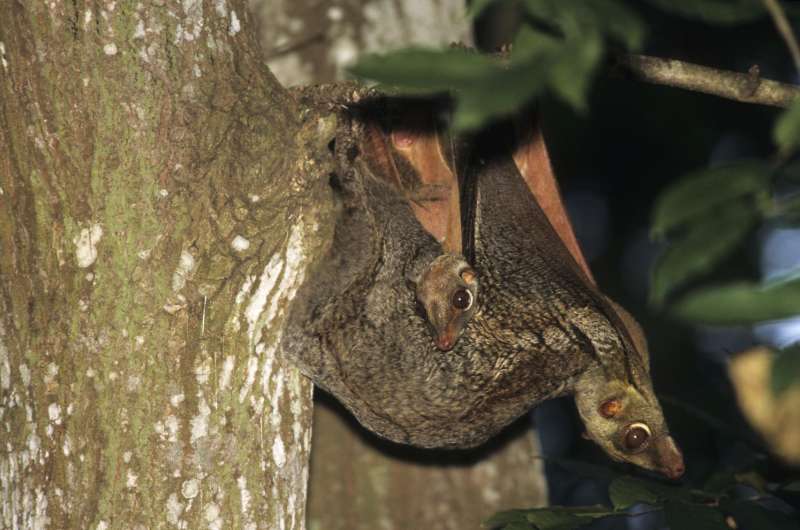A photo of a colugo, with young. Credit: Norman Lim
(Phys.org)—An international team of researchers has found genetic evidence that suggests that colugos are part of a primate sister group. In their paper published in the journal Science Advances, the team describes how they obtained tissue samples of the gliding mammals, performed genetic testing on them and found a surprising relationship between them and primates.
Scientists and casual observers alike have debated for some time the family tree of colugos (also known as flying lemurs)—many have suggested they are most closely related to tree shews due to a physical resemblance. They look a lot like bats, with stretchable membrane-like wings, but unlike bats, they cannot fly—instead they leap off branches and glide through the air in a way reminiscent of flying squirrels. They live in the treetops in remote parts of Asia and because of that have been notoriously difficult to study—making things even more difficult is their failure to survive for long in captivity. In this new effort the researchers sought to solve the question of their ancestry by conducting a DNA analysis on an available tissue sample from a specimen from West Java.
Their analysis consisted of using illumine instruments to sequence DNA from the sample which they used to create a genome assembly. In so doing they were able to identify 23,081 protein-coding genes which they then promptly compared to sequences made of other 21 mammals. They report that their analysis revealed colugos split off from other mammals approximately 80 million years ago and that the comparisons uncovered a relationship close enough to primates to call them a sister group. The team also tested tissue from a variety of colugo museum samples and in so doing discovered that there are far more species of colugos than anyone had imagined, from as few as 7 to perhaps 14.
The findings by the team are expected to contribute to a growing base of information related to the evolution of the earliest primates and may also help better understand the genetic origins of some modern human maladies—they found signs of positive selection in the colugos, for example, that if present in other mammals, may have led to night blindness and retinal degeneration.
Functional gene evolution and positive selection in colugos and ancestral primates. Colugo gliding with patagium fully extended. Credit: Mason et al. Sci. Adv. 2016; 2 : e1600633
More information: V. C. Mason et al. Genomic analysis reveals hidden biodiversity within colugos, the sister group to primates, Science Advances (2016). DOI: 10.1126/sciadv.1600633
Abstract
Colugos are among the most poorly studied mammals despite their centrality to resolving supraordinal primate relationships. Two described species of these gliding mammals are the sole living members of the order Dermoptera, distributed throughout Southeast Asia. We generated a draft genome sequence for a Sunda colugo and a Philippine colugo reference alignment, and used these to identify colugo-specific genetic changes that were enriched in sensory and musculoskeletal-related genes that likely underlie their nocturnal and gliding adaptations. Phylogenomic analysis and catalogs of rare genomic changes overwhelmingly support the contested hypothesis that colugos are the sister group to primates (Primatomorpha), to the exclusion of treeshrews. We captured ~140 kb of orthologous sequence data from colugo museum specimens sampled across their range and identified large genetic differences between many geographically isolated populations that may result in a >300% increase in the number of recognized colugo species. Our results identify conservation units to mitigate future losses of this enigmatic mammalian order.
Journal information: Science Advances
© 2016 Phys.org






















